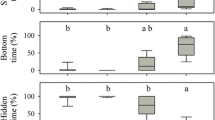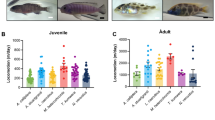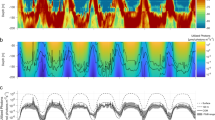Summary
Data on factors determining activity cycles of nearctic fishes are scarce overall, and nonexistent for Coregoniae (family Salmonidae), a group with closely related and somewhat better known palaearctic species. We studied effects of photoperiodicity, light intensity and temperature on diel locomotor activity of lake whitefish Coregonus clupeaformis (Mitchill). Under LD 12:12, a day-active pattern was evident. Under continuous light (LL) and continuous dark (DD), rhythmicity was greatly suppressed or absent, respectively. Day-time activity levels were positively correlated with illuminance over the range tested (0.005 to 500 lux). At the three temperatures tested, activity was lowest at 7° C, highest at 12° C (a reported temperature optimum), and intermediate at 17° C. Our results suggest that level and diel pattern of lake whitefish activity are under overriding external control, and we find similarities with published data on the European species Coregonus lavaretus.
Similar content being viewed by others
References
Aschoff J (1960) Exogenous and endogenous components in circadian rhythms. Cold Spring Harbor Symp Quant Biol 25:11–28
Beitinger TL (1975) Diel activity rhythms and thermoregulatory behavior of bluegill in response to unnatural photoperiods. Biol Bull 149:96–108
Bengtsson B-E (1974) Effect of zinc on the movement pattern of the minnow, Phoxinus phoxinus. Water Res 8:829–833
Bengtsson B-E, Larsson A (1981) Hyperactivity and changed diurnal activity in flounders, Platichthys flesus, exposed to DDT. Mar Poll Bull 12:100–102
Bernatchez L, Dodson JJ (1985) Influence of temperature and current speed on the swimming capacity of lake whitefish (Coregonus clupeaformis) and cisco (C. artedii). Can J Fish Aquat Sci 42:1522–1529
Blaxter JHS (1970)_Light: Fishes. In: Kinne O (ed) Marine Ecology, Vol. 1, Part 1 (Environmental factors) Wiley Interscience, London, pp 213–320
Bodaly RA (1986) Biology, exploitation and culture of coregonid fishes in Canada. Arch Hydrobiol Beih 22:1–30
Brown FA, Hastings JW, Palmer JD (1970) The biological clock-two views. Academic Press, New York, p 94
Bünning E (1964) The physiological clock.- Academic Press, New York p 145
Eriksson L-O (1978) Nocturanlism versus diurnalism; dualism within fish individuals. In: Thorpe JE (ed) Rhythmic activity of fishes, Academic Press, London, pp 69–89
Godin J-GJ (1981) Circadian rhythm of swimming activity in juvenile pink salmon (Oncorhynchus gorbuscha). Mar Biol 64:341–349
Halberg F (1960) Temporal coordination of physiologic function. Cold Spring Harbor Symp Quant Biol 25:289–310
Höglund LB (1961) The reactions of fish in concentration gradients. Rep Inst Freshwater Res Drottningholm 43:1–147
Jones KA, Hara TJ, Scherer E (1985) Behavioral modifications in arctic char (Salvelinus alpinus) chronically exposed to sublethal pH. Physiol Zool 58:400–412
Kavaliers M (1978) Seasonal changes in the circadian period of the lake chub, Couesius plumbeus. Can J Zool 56:2591–2596
Kavaliers M (1980) Social groupings and circadian activity of the killifish, Fundulus heteroclitus. Biol Bull 158:69–76
Kavaliers M (1981) Seasonal effects on the freerunning rhythm of circadian activity of longnose dace (Rhinichthys cataractae). Evn Biol Fish 6:203–206
Lemly AD, Smith RJF (1985) Effects of acute exposure to acidified water on the behavioral response of fathead minnows, Pimephales promeles, to chemical feeding stimuli. Aquat Toxicol 6:25–36
MacFarlane RB, Livingston RJ (1983) Effects of acidified water on the locomotor behavior of the gulf killifish, Fundulus grandis: a time series approach. Arch Environ Contamin Toxicol 12:163–168
Müller K (1978a) The flexibility of the circadian system of fish at different latitudes. In: Thorpe JE (ed) Rhythmic activity of fishes, Academic Press, London, pp 91–104
Müller K (1978b) Locomotor activity in whitefish-shoals (Coregonus lavaretus). In: Thorpe JE (ed) Rhythmic activity of fishes, Academic Press, London, pp 225–233
Popper AN, Fay RR (1973) Sound detection and processing by teleost fishes: a critical review. J Acoust Soc Am 53:1515–1529
Richkus WA, Winn HE (1979) Activity cycles of adult and juvenile alewives, Alosa pseudoharengus, recorded by two methods. Trans Am Fish Soc 108: 358–365
Scherer E, Scott KR, Nowak SH (1977) A modular large-scale laboratory system to acclimate and test aquatic organisms. Can Fish Mar Serv Tech Rep 728:vii+p10
Scherer E, Nowak SH, Harrison SE, Kripiakevich DL (1979) Testing locomotor activity responses with ultrasonic beams, p 186–194. In: Scherer E (ed) Toxicity tests for freshwater organisms. Can Spec Publ Fish Aquat Sci 44:1–194
Scherer E, Van der Veen B (1982) An ultrasonic beam actograph for laboratory and field use. Can Tech Rep Fish Aquat Sci 1137:iv+p 15
Scherer E, Harrison SE, Brown SB (1986) Locomotor activity and blood plasma parameters of acid-exposed lake whitefish, Coregonus clupeaformis. Can J Fish Aquat Sci 43:1556–1561
Schreck CB (1981) Stress and compensation in teleostean fishes: response to social and physical factors, pp 295–321. In: Pickering AD (ed) Stress and fish. Academic Press, London, p 367
Schwassmann HO (1971) Biological rhythms In: Hoar WS, Randall DJ (ed) Fish physiology. Vol. 6. Academic Press, New York, N.Y. pp 371–428
Scott WB, Crossman EJ (1973) Freshwater fishes of Canada. Bull Fish Res Board Can 184:1–966
Spieler RE, Kendall (ed) (1984) Rhythmicity in fishes. Trans Am Fish Soc 113:411–552
Thorpe JE (ed) (1978) Rhythmic activity of fishes. Academic Press, London. x+p 312
Waller WT, Cairns J Jr (1972) The use of fish movement patterns to monitor zinc in water. Water Res 6:257–269
Weis P, Weis JW (1974) DDT causes changes in activity and schooling behavior in goldfish. Environ Res 7:68–74
Author information
Authors and Affiliations
Rights and permissions
About this article
Cite this article
Scherer, E., Harrison, S.E. Exogenous control of diel locomotor activity in the whitefish Coregonus clupeaformis: effects of light and temperature. Oecologia 76, 254–260 (1988). https://doi.org/10.1007/BF00379959
Received:
Issue Date:
DOI: https://doi.org/10.1007/BF00379959




